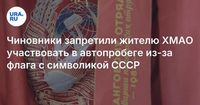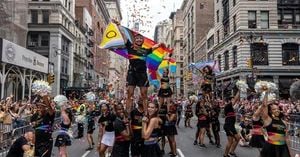On May 10, 2025, a man from Lyantor arrived at a car rally in Surgut, Russia, displaying a flag featuring the coat of arms of the Soviet Union alongside the inscription "Born in the USSR." This incident sparked a heated exchange between the man and a city official, drawing attention from onlookers and igniting a debate over the appropriateness of such symbols during public events.
The man, who had traveled from Lyantor to participate in the rally in honor of his 80-year-old grandfather, was confronted by officials who claimed that the phrase "Born in the USSR" represented a prohibited, almost terrorist symbol. This assertion was captured in a video that circulated widely on social media, particularly in the Telegram channel "CH Surgut." The video shows the man expressing his frustration, stating, "They say that 'Born in the USSR' is a banned, almost terrorist symbol. Everyone was born in the USSR; how can it be prohibited?"
In the video, the man insisted that he would not remove the flag from his vehicle, asserting the injustice of being barred from the event. His comments resonated with many viewers, as the post garnered over 200 comments, predominantly in support of his stance against the officials' actions.
Officials from the Surgut administration clarified that participants in the rally were required to adhere to specific rules regarding the materials and symbols displayed on their vehicles. They emphasized that these guidelines were established to ensure safety during the event. According to the administration, the rules were made available to all participants in advance, detailing which flags and symbols were permissible.
"In this case, the participant violated these rules, and the organizers requested him to correct the violation," officials stated. This response highlights the ongoing tension between individual expression and regulatory compliance in public events.
Furthermore, a source familiar with the situation suggested that the uproar and defiance exhibited by the man appeared to be an artificially created wave, indicating that there may have been underlying motivations for the confrontation. Police were present at the rally, checking each vehicle and asking participants to remove any tinting or unauthorized posters and stickers, except for those that had been pre-approved. All other participants complied with these requests and were allowed to proceed without incident.
Commentators on social media pointed out that the use of the Soviet coat of arms and the phrase about being born in the USSR could be linked to the banned organization "Citizens of the USSR," which has been classified as extremist and prohibited in Russia. This connection adds another layer of complexity to the discussion surrounding the use of Soviet symbols in contemporary Russia.
The incident raises important questions about the boundaries of free expression in public commemorations, especially in a country where the legacy of the Soviet Union remains a contentious topic. While many view the symbols of the USSR with nostalgia, others associate them with a painful past and the political repression that characterized that era.
As discussions continue about the appropriateness of Soviet symbols in public life, this incident in Surgut serves as a potent reminder of the ongoing struggle between historical memory and modern political realities. The clash between the man from Lyantor and the city officials not only reflects personal grievances but also highlights broader societal tensions regarding identity, memory, and the interpretation of history.
In conclusion, the events surrounding the car rally in Surgut illustrate the complexities of public expression in a nation grappling with its past. The conversation sparked by this incident may lead to further examination of the rules governing public events and the symbols deemed acceptable in contemporary Russia.




